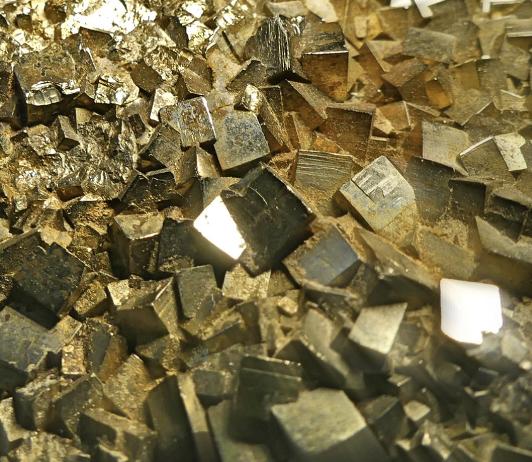I stumbled upon an interesting abstract of a recent presentation at the European Geosciences Union (EGU) General Assembly 2024, Vienna, Austria (in case you happened to miss it). The title, "Potential lithium enrichment in pyrites from organic-rich shales," won't raise many eyebrows, but there's some interesting and potentially useful stuff in there. Here's the abstract.
Pyrite, aka, "fool's gold" isn't just a pretty face; it could be another source of lithium – the "hot" element of the decade because of the demand for "clean" electric power in the form of lithium-ion batteries. (If you Google lithium shortage you'll get 4.5 million hits.)
Although fool's gold (aka pyrite, iron disulfide) has generally been regarded as useless, (except for its gorgeous crystals), EGU presentation hints otherwise. Apparently, deposits of pyrite contain more lithium than would be expected, perhaps making fool's gold not so foolish.
The group, led by Shikha Sharma, Professor, Department of Geology and Geography at West Virginia University, discovered that in 15 rock samples from the Appalachian basin, there was an inordinate amount of lithium found in pyrite.
[This] is unheard of...I am trying to understand how lithium and pyrite could be associated with one another.
Shailee Bhattacharya, a sedimentary geochemist and doctoral student working in Professor Sharma's lab
Indeed, if there is a chemical reason why lithium should interact with iron disulfide it's news to me. The group postulates that lithium in the form of lithium sulfide (Li2S) may be found in pyrite deposits because of the temperatures at which pyrite forms:
Li mobility is highly sensitive to small increases in temperature, the very high thermal maturation of the studied shale sequence may have significantly impacted Li remobilization during the smectite-to-illite clay-mineral transformation. The common Li-mineral that can coexist with different phases of FeS is Li2S at temperatures ⩽ 75°C – 135°C. Several reaction mechanisms have been proposed, but there is little known about the rate kinetics and reaction steps involved in Li association with pyrite in shales.
Bhattacharya, et. al., EGU General Assembly 2024, Vienna, Austria, 14–19 Apr 2024, EGU24-369, https://doi.org/10.5194/egusphere-egu24-369, 2024.
If these findings hold up in other sampling areas lithium mining, which is very expensive, technically difficult, and damaging to the environment could become less so, since new mines would not have to be dug. Instead, lithium could be extracted from materials from previous mining operations and generate little or no new waste material.
More about fool's gold
Pyrite is a very common mineral; its nickname was first used in a derogatory manner. But it sure is pretty.

Three different samples of pyrite, right out of the ground. The reason for the gold comparison should be obvious. Photos: Flickr, Flickr, Wikimedia Commons
Why is it shiny?
Pyrite has nothing in common with gold. Even the resemblance is a coincidence.
The luster is a result of its cubic crystal structure and the interaction of light with its surface. When light hits the surface of pyrite, it stimulates the electrons within the material, causing them to vibrate. The vibration causes the emission of a yellowish light that just happens to look like the reflection of light from the surface of gold. The two mechanisms are related but different (this has to do with the electronic configuration of the outer orbitals of iron and sulfur. The two together mimic the gold color - something you could have easily lived your entire lives without knowing.)
Real fools, real fool's gold
Entering the bizzaro world of therapeutic crystals we find some (predictably) strange s### – claims of the utility of fool's gold, not presented in order of foolishness. The website AVO Crystals provides as good an example as any. Here are some:
-
"Pyrite, with its golden color and shimmering luster, has long been revered for its ability to bring financial success and opportunities. Many believe that pyrite has the power to manifest money and abundance in one’s life."
Yes, it brings money when you sell it to nutlogs who believe in its magical powers. But even they must use it properly...
- "In Feng Shui, placing pyrite in the wealth corner of a space, which is the top left corner, is believed to attract abundance and prosperity."
My home has no "wealth corners," whatever the hell they are. And if you worked for ACSH you'd be lucky to afford any home, corners or not. I'm one of the lucky ones...

The Jman enjoys his spacious ACSH housing.
- "One key attribute of pyrite is its ability to deflect negative energy and create a protective shield around the wearer [making it] an excellent crystal for those who are sensitive to external energies or who wish to maintain a sense of grounding and balance throughout their day."
That's what the bird is for.
- "Pyrite’s energy aligns with the solar plexus, sacral, and root chakras, allowing it to tap into our inner strength, creativity, and grounding. It helps us connect with our true passions and unleash our fullest potential."
My chakra is telling me that it's time to end this wretched article.
Namaste.




